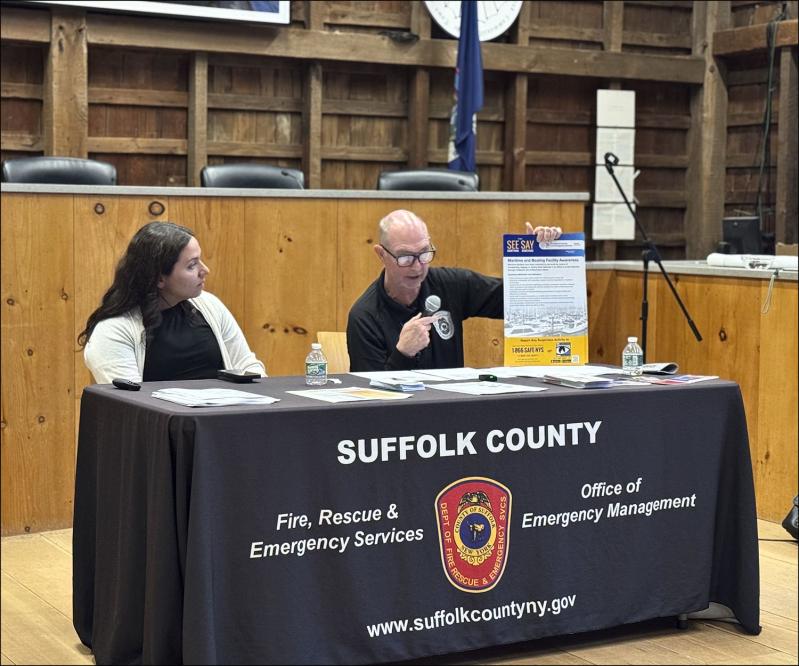“East Hampton is especially vulnerable to natural hazards like storms, wildfire, and coastal flooding, and those threats are increasing with climate change,” Town Supervisor Kathee Burke-Gonzalez said during a brief introduction at an emergency preparedness night at Town Hall on Monday. “The goal tonight is to make sure every resident knows how to prepare, where to go, and who to turn to when emergencies happen.”
The presentation was led by Doug Shearer, community emergency evacuation coordinator, and Allison Aievoli, acting director of emergency preparedness — both of the Suffolk County Department of Fire, Rescue and Emergency Services (FRES) Office of Emergency Management, based in Yaphank.
“Really what I’d like to make sure is that when we leave this presentation, or when we show it again, I hope that you have a better understanding, and a level of awareness, of summer weather,” Mr. Shearer began, noting that though these weather events bring with them “a lot of things that can cause a lot of problems,” careful preparation can help ensure the safety of individuals and their loved ones.
He provided a general overview of the role their office plays in coordinating the county’s response to natural and manmade disasters, in collaboration with officials at federal, state, and local levels, and outlined their four phases of emergency management: mitigation, preparedness, response, and recovery.
“But what I want you to take away from this, is I want you to do the same thing that we do in the office,” he added. The presentation featured examples of past severe weather events in Suffolk County, and some of the specific fallout communities experienced in their aftermath, to provide an idea of how residents might prepare for future occurrences.
Ms. Aievoli pointed to the example of the catastrophic flooding on the North Shore last August: “Everyone had all of their files, insurance documents, in their basements, and their basements had anywhere from eight to 10 feet of flooding. And they lost everything,” she said. She recommended that anyone living in a storm surge zone find a “better place” now for important belongings.
Other practical suggestions included the preparation of a “go-bag” containing basic supplies, medications, and enough food and water to last for at least three days, as well as the establishment of a specific household communication plan, which includes writing down important contact numbers, somewhere easily accessible. “How many phone numbers, without going through your phone right now, can you honestly remember off the top of your head?” she pointed out.
They also identified resources available free of charge to all county residents, including a locator tool for emergency shelters and evacuation centers, the “Know Your Zone” interactive storm surge map, and SuffolkAlert, the county’s official emergency notification system, for which residents can sign up to be informed of emergency updates by text, email, or voice message. Users also have the option of creating a “safety profile” through a nationwide program called Smart911, which securely stores important information that can be accessed by first responders across the country in the event of an emergency — more information can be found on the FRES website.
“I want to add one thing before we close here — we go through emergencies not as individuals, but as communities. Get to know your neighbors,” Mr. Shearer recommended. “Try to work within a community function, because we’re going to go through it together.”
The PowerPoint from Monday’s presentation is to be available on East Hampton Town’s website, and a full recording of the event can be viewed on LTV East Hampton’s YouTube channel.




